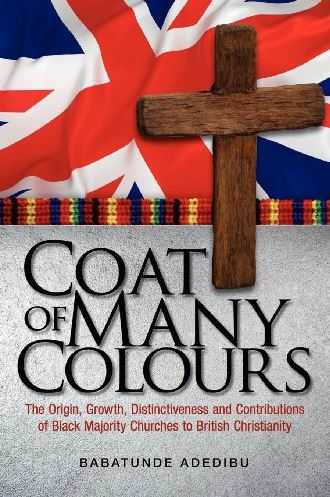Reviewed by David Goodhew, Cranmer Hall, Durham
Book Review: Babatunde Adedibu, Coat of Many Colours, (Choir Press, 2012)
Coat of Many Colours is an important book on a crucial subject for British Christianity. This volume explores the origins, growth, distinctive theology and practices and significance (religious, social and political) of black majority churches (BMCs) in Britain. Adedibu then stands back and looks at the potential and future pitfalls for BMCs.

A great strength of this volume is the authors considerable scholarship across theology and history, combined with the authors sustained involvement in BMCs and particularly the Redeemed Christian Church of God, involvement in the wider British churches and alertness to broader cultural trends – all backed by a huge quantity of reading. This account has the virtues of being that of an academic, but also that of an insider.
The volume can be read with profit for a wide range of nuggets of detail. These include a fascinating portrait of Thomas Bren Wilson, of Sumner Chapel, the first black pastor in modern British history – showing we should not see BMCs as simply the result of the Windrush generation. Adedibu is very helpful in making connections between BMCs and Pentecostalism – reinforcing Newbigin’s comment that Pentecostalism was the biggest Christian innovation in the 20th century.
More generally, Coat of Many Colours sets the growth of BMCs within the wider currents of British black history. Windrush was not just a social, economic and political event – it was a religious event too. Key figures in black British history such as Harold Moody embody the intertwining of faith and politics. Adedibu concludes that it is a mistake to see societal racism as the only cause of the formation of BMCs. BMCs were also meeting spiritual and cultural needs unmet in wider denominations. And the ‘mainstream’ denominations need to beware the notion that it was just racism that compromised their witness amongst black people – it was the fruit of spiritual weaknesses and cultural straightjackets too. Coat of Many Colours is also alert to developments beyond Britain. As early as the 1950s, American missionaries were seeing Britain as a mission field. ‘Reverse mission’ is older than many realise. Coat of Many Colours is alert to the variety within BMCs, especially the variation between those with roots in the Caribbean and those whose roots are in Africa.
Adedibu’s work chimes with work that appeared just after Coat of Many Colours was published – especially the results for Peter Brierley’s census of London churches and Andrew Rogers’ report on BMCs in a single London borough. These two works back up Adedibu on many points – most especially in showing the huge proliferation of BMCs in London. Adedibu, together with the scholars just named, have shown the ‘southenisation’ of the capital of Britain.
In terms of theology, Adedibu stresses the experiential nature of BMCs, their focus on the Bible (especially literal interpretation) and pneuma-centrism. He considers the role of ‘prosperity gospel’ within BMCs. Adedibu contrasts all this with what he sees as the more rationalistic white denominations.
But the volume is no hagiography. Adedibu is not afraid to criticise BMCs – describing and evaluating various administrative and financial improprieties of recent years. Indeed, in his concluding remarks Adedibu offers a range of challenging questions for the world of BMCs which he knows so well. He asks whether the BMC’s, by their importation of African and/or Caribbean culture, are in danger of doing in Britain what the British churches often did in Africa – imposing a non-indigenous form of the gospel. Coat of Many Colours can be read as a call for the indigenisation of BMCs – which Adedibu sees as depending upon: the creation of a back intelligentsia; reappraisal of theology (although Adedibu is careful to stress the retention of Pentecostal ideals); social action (which will assist attempts to connect with non-black populations) and greater engagement with ecumenism.
This is a challenging agenda which creatively calls on BMCs not to bask in the numerical growth that they (mostly) have enjoyed in recent decades. Those inside the BMC world will need to ponder hard as to how to respond to Adedibu’s challenges.
Coat of Many Colours has many strengths, but it also raises a number of questions:
- there are accounts that some BMCs are beginning to struggle to disciple young black people, who are feeling the force of Britain’s hugely powerful secularising culture. Adedibu assumes the main issue is indigenizing the gospel for non-black people. But is the need for outreach closer to home?
- Coat of Many Colours says much concerning West African BMCs. It would be good to hear more about African BMCs which come from Britain’s sizeable populations which hail from East and Southern Africa – from countries such as Kenya or Zimbabwe.
- Adedibu sees ecumenism as a key priority, but does not discuss the often moribund state of official ecumenism. How should BMCs work for unity in way that avoids the fate of official ecumenism?
Coat of Many Colours is an important work that synthesizes history and theology and offers a serious agenda for BMCs in the coming decades. It is soundly based in contemporary scholarship and raises many good questions. How those questions are answered will have a major impact on the shape of Christianity in Britain in the coming decades.
David Goodhew
Cranmer Hall
St Johns College
Durham